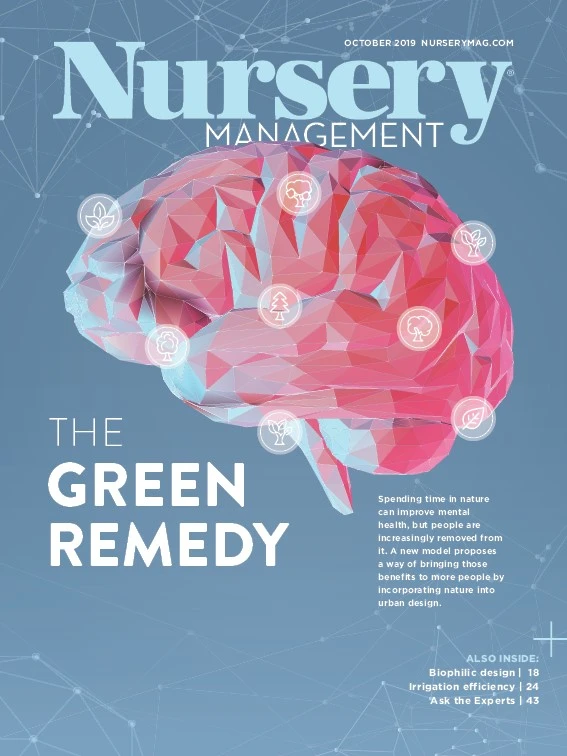
Adobe Stock


Mental health is one of the newest metrics to be considered an “ecosystem service” – a benefit people receive from the natural environment. But the concept itself isn’t new because many governments already consider other valuable ecosystem services during development planning. For example, trees are planted in cities to improve air quality or reduce urban heat island effects, and parks are built in specific neighborhoods to encourage physical activity. According to an international team of researchers, the mental health benefits of nature should also be considered when introducing holistic advantages to people.
Almost one in five adults in the U.S. lives with a mental illness, according to the National Institute of Mental Health. That statistic is similar worldwide, with an estimated 450 million people currently dealing with a mental or neurological disorder. Of those, only about a third seek treatment.
Interacting with nature is starting to be recognized as one way to improve mental health. Several scientific studies have shown that nature experiences may benefit people’s psychological well-being and cognitive function. But it has been difficult to find ways to quantify these benefits in a useful manner for cities or organizations that want to integrate nature to improve mental health.
Now, an international team led by the University of Washington and Stanford University has created a framework for how city planners and municipalities around the world can start to measure the mental health benefits of nature and incorporate those into plans and policies for cities and their residents. For people in cities, that could mean things like more neighborhood parks, trees planted along streets or better transportation infrastructure to access existing natural areas.

The team’s study was published July 24 in Science Advances.
“Thinking about the direct mental health benefits that nature contact provides is important to take into account when planning how to conserve nature and integrate it into our cities,” says Greg Bratman, lead author and an assistant professor at the UW School of Environmental and Forest Sciences. “The purpose of this paper is to provide a conceptual model of one way we can start to think about doing this.”
The study brought together more than two dozen leading experts in the natural, social and health sciences who study aspects of how nature can benefit human well-being. Their first step was to establish a baseline, collective agreement regarding the understanding of the impacts of nature experience on aspects of cognitive functioning, emotional well-being and other dimensions of mental health.

“In hundreds of studies, nature experience is associated with increased happiness, social engagement, and manageability of life tasks, and decreased mental distress,” says senior author Gretchen Daily, faculty director at the Stanford Natural Capital Project. “In addition, nature experience is linked to improved cognitive functioning, memory and attention, imagination and creativity, and children’s school performance. These links span many dimensions of human experience and include a greater sense of meaning and purpose in life.”
While this line of study is still emerging, experts agree that nature can reduce risk factors for some types of mental illnesses and improve psychological well-being. They also agree that opportunities for nature experiences are dwindling for many people around the world because of urban growth.
“For millennia, many different cultures, traditions, and religious and spiritual practices have spoken directly to our deep relationship with nature. And more recently, using other sets of tools from psychology, public health, landscape architecture and medicine, evidence has been steadily gathering in this emerging, interdisciplinary field,” Bratman says.
The study outlines how city planners, landscape architects, developers and others could eventually anticipate the mental health impacts of decisions related to the environment.
Many governments already consider this with regard to other aspects of human health. For example, trees are planted in cities to improve air quality or reduce urban heat island effects, and parks are built in specific neighborhoods to encourage physical activity. But these actions don’t usually directly factor in the mental health benefits that trees or a restored park might provide.

“We have entered the urban century, with two-thirds of humanity projected to be living in cities by 2050. At the same time, there is an awakening underway today, to the many values of nature and the risks and costs of its loss,” Daily says. “This new work can help inform investments in livability and sustainability of the world’s cities.”
The research team built a conceptual model that can be used to make meaningful, informed decisions about environmental projects and how they may impact mental health. It includes four steps for planners to consider: elements of nature included in a project, say at a school or across the whole city; the amount of contact people will have with nature; how people interact with nature; and how people may benefit from those interactions, based on the latest scientific evidence.
The researchers hope this tool will be especially useful in considering the possible mental health repercussions of adding — or taking away — nature in under-served communities.
“If the evidence shows that nature contact helps to buffer against negative impacts from other environmental predictors of health, then access to these landscapes can be considered a matter of environmental justice. We hope this framework will contribute to this discussion,” Bratman says. “Eventually, it could be developed and potentially used to help address health disparities in under-served communities.”
For the entire study, visit the: https://advances.sciencemag.org/content/5/7/eaax0903

Explore the October 2019 Issue
Check out more from this issue and find your next story to read.
Latest from Nursery Management
- A letter from the sponsor: Janna Beckerman, Envu
- John Ruter shares UGA's latest woody and herbaceous ornamental plant breeding projects
- Voting now open for National Garden Bureau's 2026 Green Thumb Award Winners
- Conor Foy joins EHR's national sales team
- Pantone announces its 2026 Color of the Year
- Syngenta granted federal registration for Trefinti nematicide/fungicide in ornamental market
- Get to know Kayela Aeppli
- HILA 2025 video highlights: John Gaydos of Proven Winners





